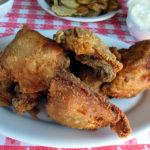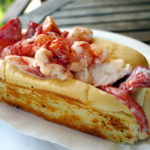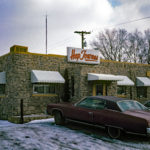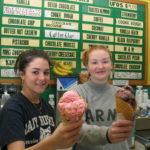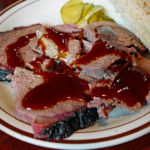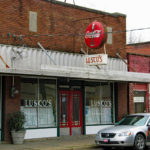On the Santa Fe Plaza
The vendor wars have ended in Santa Fe. Calm reigns on the Plaza, where, seven years ago, the lady with the churros wagon so resented the competition from Speedy Fred's snow-cone cart that she flattened the tires on his customers' cars, and Speedy Fred, thinking that the wiener vendor did it, punched the wiener vendor in the nose. Now the Plaza at the center of New Mexico's state capital is a peaceable kingdom of good fast food, purchased either from vendors' carts or from restaurants nearby. Accommodations for alfresco customers include park benches, a cool concrete ledge surrounding the central obelisk, green grass for lounging, and sidewalks for sauntering. Overhead is a high desert blue sky, and all around are soft-edged old adobe buildings. The Plaza can be noisy, but nicely so (throbbing boom boxes and ten-thousand-dollar car stereos are rare): As you dine, you hear the sounds of compadres conversing, lovers flirting, a poet reading to a handful of pals. What a dandy place to take a break or—better yet—eat Frito pies, chili-stuffed sopaipillas (fried bread), and carnitas.
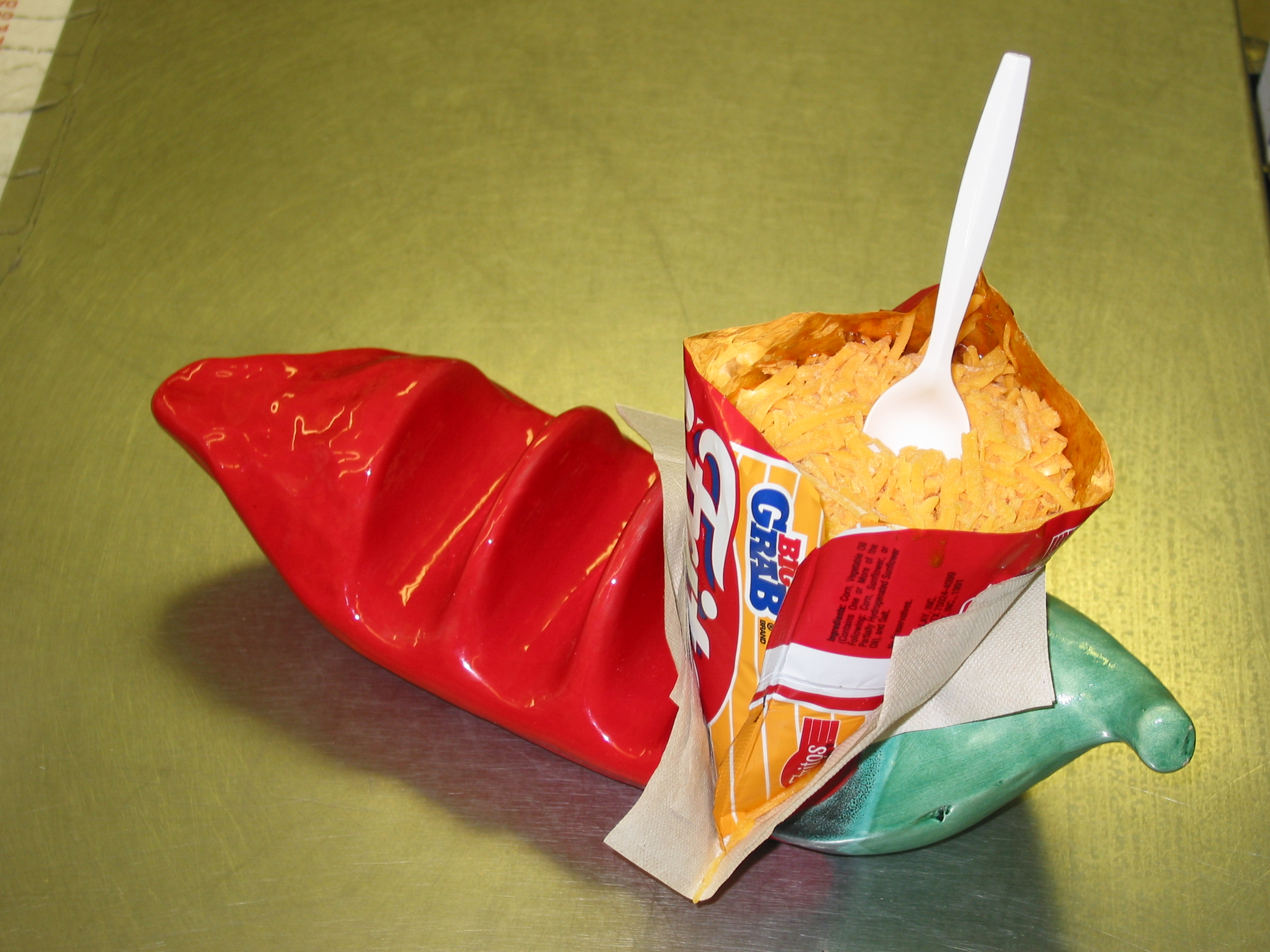
The vendor wars have ended in Santa Fe. Calm reigns on the Plaza, where, seven years ago, the lady with the churros wagon so resented the competition from Speedy Fred’s snow-cone cart that she flattened the tires on his customers’ cars, and Speedy Fred, thinking that the wiener vendor did it, punched the wiener vendor in the nose. Now the Plaza at the center of New Mexico’s state capital is a peaceable kingdom of good fast food, purchased either from vendors’ carts or from restaurants nearby. Accommodations for alfresco customers include park benches, a cool concrete ledge surrounding the central obelisk, green grass for lounging, and sidewalks for sauntering. Overhead is a high desert blue sky, and all around are soft-edged old adobe buildings. The Plaza can be noisy, but nicely so (throbbing boom boxes and ten-thousand-dollar car stereos are rare): As you dine, you hear the sounds of compadres conversing, lovers flirting, a poet reading to a handful of pals. What a dandy place to take a break or—better yet—eat Frito pies, chili-stuffed sopaipillas (fried bread), and carnitas.
The critics’ choice among the four food vendors now allowed by city ordinance to park their rolling carts around the Plaza is ROQUE’S CARNITAS, located on Washington Avenue just around the corner from the portal of the Palace of the Governors. Roque Garcia and his partner, Mona Cavalli, station their chuck wagon in this spot just before lunchtime, usually every day but Tuesday, beginning at Easter and continuing at least until Halloween (and sometimes as late as Thanksgiving). Dining at Roque’s is strictly informal. There are no white-clothed tables, no slick young wait-staff, no wine list, and no celebrity chef cleverly reinventing Southwestern cuisine. Pay Mona $3.50, plus the cost of your lemonade or soda, and then find a place to feast on a simple pleasure that no pretense could improve.
What you get, folded inside a sturdy flour tortilla that has been heated over a charcoal fire, is meat and plenty of it—top round, sliced thin and seasoned with a garlic and soy sauce marinade. “We are New Mexican, not Mexican,” explains Mona, who moved to Santa Fe from New York City some thirty years ago. “That is why we use beef rather than pork, and flour tortillas rather than corn.” At the wagon, mounds of this sopped beef are cooked on a grate over a hot open fire with sliced yellow onions and sliced green chilies (New Mexican chilies in the fall, when they are in season, and Anaheim’s the rest of the time). The mélange is tossed vigorously with tongs as the meat chars along the edges, engulfed in smoke, and the onions and peppers turn limp. Nearly a half pound of it is piled into the tortilla and topped with a salsa made from tomatoes, onions, and chopped jalapenos. (Fresh cilantro used to be an option: Mona kept a small pot of it growing adjacent to the wagon, but people kept yanking it out by its roots, so she gave up. “I wouldn’t have minded if they came along and cut some leaves for themselves, because it grows fast enough,” she says, “but I couldn’t keep replanting it.”) The hefty sandwich is then tightly wrapped in aluminum foil so it can be carried without serious spillage.
It is a jolly mess. As soon as you peel back the foil and try to gather up the tortilla for eating, chunks of salsa tumble out, meat juices leak, onions slither, and plump circles of chilies pop free. The choice location for eating is on the Plaza itself, on a bench. Here you can sit and lean far forward as you dine, thus sparing your shirt and lap—and providing resident pigeons the carnita banquet to which they are now accustomed.
Roque is a native New Mexican, born and raised in Santa Fe, and so familiar with local ways, he boasts that he “can see someone and tell you if they are from Santa Fe, Espanola [twenty miles north], or Las Vegas [New Mexico, not Nevada—it’s forty miles east], just by the way they walk and dress. Espanolas wear lighter colors, cowboy shirts—real ones, not fancy—and Wranglers. In Las Vegas, they are more patient, more calm. Santa Feans are faster; we move quickly; our clothes are bright. After all, we are becoming a big city.”
Santa Fe was not yet a big city when Roque, now in his mid-fifties, grew up near the Plaza, but its culture has always been a lush one, and it has long been known for its exotic food. Roque remembers well how many street vendors there used to be around town—people hawking tamales, boiled eggs, taquitos (little tacos), even pigs’ feet, from carts or walking from bar to bar, offering their wares to patrons.
It was those memories that inspired his carnita wagon. Ten years ago, after the fall harvest, Roque and three of his buddies were sitting around drinking beer and roasting chilies. They got hungry. Roque went to the refrigerator and found a rump roast. Recalling a meat-and-chili meal his mother used to make for him and his eleven brothers and sisters, he cut up the roast, cooked it with peppers, and served the mixture in flour tortillas. “If you have garlic and oregano, you can do almost anything,” says Roque, who has been in the restaurant trade most of his life. His friends liked what he served so much that they decided to start selling sandwiches of carnitas (which means “little meats” in Spanish) from a wagon on the Plaza.
The plan was that Roque would make carnitas and another of the partners would make what are known as hand pies, a kind of vernacular croque-monsieur of ham and cheese between bread cooked in a mold over an open fire. But there was a big problem: Ten years ago there were no clear laws about outdoor food vending in Santa Fe. Almost as soon as Roque opened up, the health department demanded to know, Where is the washroom? Roque pondered the question and answered with signed letters from the officer of a nearby museum and from a bigwig at the bank on the Plaza saying the Roque’s staff (he and Mona) were allowed to use their restrooms. That—and installing hot running water in the cart—got Roque a reprieve, and he soon bought out his partners and eliminated the hand pies, which weren’t selling nearly as well as the carnitas. However, as Santa Fe grew and more vendors moved onto the Plaza, the situation grew ugly. “They were crazy years,” Roque recalls about the now infamous “vendor wars” when fights broke out over who could park where. On the day the big battle (between Speedy Fred and the wiener man) took place and made front page news in the local paper, Roque himself managed to avoid becoming a casualty, he says, only because he hadn’t yet arrived that morning.
Peace was established six years ago, when the city had vendors draw lots for the locations. Roque drew what was widely considered the worst spot—not even really on the Plaza, but around the corner to the northeast on Washington Avenue. No vendor had ever set up there because no one wanted to be away from the Plaza’s pedestrian traffic. And, besides, smoke from Roque’s charcoal grill tended to set off the fire alarm in the nearby Museum of Fine Arts. However, that smoke, redolent of sizzling beef and onions and peppers, also turned out to be Roque’s secret weapon. When the wind is blowing right, you can smell carnitas halfway across the Plaza, and so even those who might not see the wagon are drawn to it by the tantalizing aroma.
The side street also provides an unexpected benefit: drive-by business. The customers don’t even have to get out of their cars. Usually, Washington Avenue moves leisurely enough that many people simply pull up alongside the wagon, shout their orders, and wait a minute to pick them up. If the streets are especially congested, Mona and Roque know to look north on Washington, where approaching buyers hold their hands out of their car windows with fingers raised to indicate the number of carnitas they want. By the time they arrive at the wagon the sandwiches are wrapped and ready, cash is exchanged, and they are on their way with hot lunch.
Six days a week, when the weather permits, you’ll find the wagon parked in this location, unless Roque and Mona feel the need for a little rest. (For those who love carnitas, wondering if Roque’s is open becomes a nerve-racking daily exercise.) They do a huge amount of work at home every night and morning to get ready—all by hand, all by themselves. The meat is cut into thin strips and marinated for a minimum of twenty-four hours. Despite the best efforts of slicing-machine salesmen to convert him to modern ways, Roque slices all the onions by hand, bag-fuls every day. It is an amazing sight to see him peel and cut each big onion faster than any machine could do it, so fast and furious that he frequently suffers from tennis elbow from the effort. Both Roque and Mona cut the chilies; Mona makes the marinade and salsa. And at the wagon they both cook, serve, and hobnob with customers.
Although the carnita wagon attracts many strolling tourists, at least half the lunch crowd each day is local. In the first week after Roque and Mona have returned from their winter vacation, around Easter time, cars cruise past on Washington Avenue tooting their horns to welcome them back. For many Santa Feans, the charm of Roque’s—apart from its food—is its simplicity. The carnita wagon is a reminder of an older Santa Fe before the city was quite so chic, when the Plaza was less a magnet for visitors and more a town square where citizens came to shop, meet, and play. “People really used the Plaza back then,” Roque reminisces. “There were grocery stores, shoe stores, drugstores. This was the place where all of Santa Fe felt at home. The Plaza was filled with pigeons and children chasing pigeons.”
Some of the old stores around the Plaza have given way to expensive gift shops, and there are citizens who feel disaffected by the fashionable dining rooms and galleries. New deluxe restaurants seem to open every month, but one vintage haunt, right on the Plaza, seems hardly to have changed at all. PLAZA RESTAURANT (also known as the Plaza Cafe), to the west on Lincoln Avenue since 1918, is one of the oldest restaurants, if not the oldest, in Santa Fe. Its interior features a lovely checked tile floor, chrome-banded tables, spinning fans hung from a stamped tin ceiling, and a low counter with a view of six clocks showing the time of day in Sydney, Beijing, Addis Ababa, Athens, Rio de Janeiro, and Santa Fe.
The menu is a savory combination of Greek diner standards (lamb meat loaf, souvlaki, Greek salad) and real New-Mex specialties including chiles rellenos, pozole with pork, menudo (tripe soup), and red chili or green chili stew. And, for picnicking on the Plaza, the Plaza’s sopaipillas are available to go every morning starting at about eleven. Fresh and hot and almost painfully flaky, these little golden pillows of quick-fried dough come four to a white paper bag with squeeze-packs of honey. They are wonderful to eat plain—nearly air-light, but with a satisfying bready crust—but can be even more fun with a cup of Plaza Restaurant chili con carne on the side. The green chili is soupy and hot; the red is thicker and hotter. If you are sitting down on a bench on the Plaza, either chili can easily be dolloped inside a warm sopaipilla to make a delicious (if perilously sloppy) meal.
One of the great old-time eateries still thriving on the Plaza is the lunch counter at F. W. WOOLWORTH. It isn’t only the food that makes a meal eaten here (or taken out from here) so special; it is also the ambiance, the service, the whole experience. The magic wallops you the moment you walk in the door and inhale the distinct dime-store aroma that combines dry goods, lampshades, liniments, face creams, foot powder, penny candy, cheap soft-center chocolates, and a long lunch counter with an open grill. Some of the inventory is distinctly New Mexican: sacks of blue popcorn, archery sets with suction cup arrows, inexpensive concha belts, and reproductions of magnificent historical photographs taken by B. G. Randall at Taos Pueblo in 1905. In this store, trendy Santa Fe evaporates and you realize you are in a small Southwestern city with small-city charms that preexisted its elevation to the modern paradigm of New West Style.
For example, that lunch counter. There, they do not serve sun-dried tomato quesadillas or goat cheese bruschetta (both favorites at the far-famed and luxurious Coyote Cafe). Instead, the menu features roast torn turkey with dressing and cranberry sauce, liver and onions, and baked meatloaf with gravy—all served on unbreakable plates at a Formica counter under bright fluorescent lights. The store-long counter, with red upholstered stools and booths, also offers local specialties, but they are not of the swanky, bright-young-chef variety. They include chili cheeseburgers, tortilla burgers, chili dogs, burritos, and bowls of red or green chili with saltines.
The piece de resistance, however, at the counter seats as well as at the take-out stand up front, is the Frito pie. A giant Frito pie—the largest size, it costs four dollars—consists of a big soup bowl of corn chips blanketed with meat-and-bean red or green chili and a heap of shredded orange American cheese (chopped onions and sliced jalapenos are optional). It is an inspired combination of ingredients. Unlike almost any other dish (except perhaps a hot fudge sundae, in which the ice cream melts as it warms and the fudge thickens as it cools), Frito pie dramatically changes consistency while you eat. The dynamics are not thermal, however; they are more a matter of textural flux. The Fritos start out crisp, but as soon as the chili is ladled on they begin to soften. Those chips completely inundated at the bottom of the bowl thicken, gradually becoming an earthy cornmeal pad underneath the spicy meat and beans. Other chips at the edge of the bowl and those at the very bottom retain varying degrees of crispness. Because the chili is scooped onto the chips hot from the kettle, the shreds of cheese that go atop it liquefy instantly, the bottommost shreds blending into the meaty brew.
Giant Frito pies are not available to go because they are simply too big to carry securely. You can get only a regular size at the take-out counter. But that brings us to some bad news: One wonderful element of Woolworth’s Frito-pie-to-go has vanished. It is no longer served inside a Fritos bag. Until a little over a year ago, each pie was made by ripping open a wax-paper bag of Fritos (small or large), piling in all the other ingredients, and then planting a plastic fork in the center. However, as the lunch counter manager explained, Frito-Lay changed the bag’s consistency. “The new bags aren’t strong enough,” she said. “The chili leaks. No one wants a wet-bottomed Frito pie.” Cardboard boats have been substituted; while the ingredients are as good as ever, the presentation of the dish has suffered.
The person who configured the Frito pie in its now-classic arrangement still works at Woolworth’s. Teresa Hernandez came to Santa Fe from the nearby mining town of Madrid in the early 1950s. She was impressed by a dish served at local drive-ins: a paper cup full of chili on a bed of shredded lettuce, garnished with a handful of Fritos. She recalls, “When I came to work at Woolworth’s, I thought maybe we could make a different kind of Frito pie. My idea was to eliminate the lettuce and to use the Fritos on the bottom. Mr. Donald Skelton, who was the manager then, and myself, we decided to use a Fritos bag instead of the paper cup. Schoolchildren liked it the most. They used to come in after school or during their lunch hour and buy Frito pies so they could eat them while they walked around the Plaza. That’s what’s good about a Frito pie: You can eat it sitting down or on your way to work. It’s so easy.”
Cliff Mills, manager of the store’s souvenir department (and great-grandson of photographer B. G. Randall), explained, “Everybody who is anybody in Santa Fe eats at Woolworth’s,” and to prove his point he enumerated many state government officials who have dined on Frito pie, as well as such visiting connoisseurs as Carol Burnett, Paula Abdul, Terry Bradshaw, Donald Sutherland, and Mean Joe Greene. Celebrities notwithstanding, it is ordinary townsfolk who have made Woolworth’s Frito pie a culinary star. We witnessed a man in mechanic’s overalls step up to the crowded take-out counter around lunchtime last October and announce to one and all that it was his birthday. “A giant Frito pie!” he expansively decreed. When told that giant pies were available only to those who were seated, the jubilant gentleman thought a moment, then decided to shoot the works: “Two regulars and a corn dog!” he proclaimed. He paid with a personal check for $9.11, then walked out into the crisp autumn air, balancing two Frito pies and a dog-on-a-stick in his arms as he looked for a park bench on the Plaza where he could kick back and relish his birthday banquet.
F. W. Woolworth (permanently closed)
60-62 East San Francisco Street
Santa Fe, New Mexico
Corner of Washington and East Palace avenues
Discuss
What do you think of On the Santa Fe Plaza?
Related Articles
Stroud’s
By Jane and Michael Stern Originally Published 1995 Gourmet Magazine Chicken...
The Lobster Roll Honor Roll
Maine is the only state in America that features a picture of cooked food on its license...
Meat-And-Three
A few years back, country singer Ray Stevens invited a New York friend to join him at one of...
Top 12 favorite Ice Cream Scoops
WITH THE EXCEPTION of the hot dog bun, there has never been an edible invention as...
Top 5 BBQ Restaurants | Western Kentucky
Get yourself to Western Kentucky for great BBQ I see the food shows on TV where...
Best restaurants in Greenwood, MS | Hot Licks Delta Style
Ever since we first ate margarine-sauced pompano at Lusco’s, in Greenwood,...

